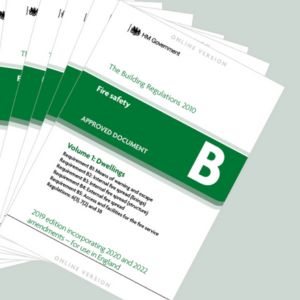
Understanding Part B of Building Regulations and its Relevance to Electrical Installations in Buildings
When it comes to ensuring the safety and well-being of occupants within a building, few things are as critical as adhering to building regulations. Part B of the Building Regulations, often referred to as Part B, addresses fire safety and has a significant impact on various aspects of a building’s design and construction. In this blog, we will delve into the importance of Part B in relation to electrical installations, highlighting the key considerations and guidelines that need to be followed to ensure a secure and compliant environment.
Part B: A Brief Overview
Part B of the Building Regulations in many countries outlines the fire safety requirements that a building must meet to safeguard its occupants in the event of a fire. The primary objective is to restrict the spread of fire and smoke within the building, allowing occupants enough time to evacuate safely and enabling fire services to manage the situation effectively.
Electrical Installations and Fire Safety
Electrical installations play a pivotal role in modern buildings, powering everything from lighting to communication systems. However, they also pose a potential fire hazard if not designed, installed, and maintained correctly. Part B recognizes this and provides specific guidelines to ensure that electrical systems do not contribute to the risk of fire.
Key Considerations for Electrical Installations under Part B
Circuit Protection: Part B mandates the use of appropriate circuit protection measures, such as circuit breakers and fuses. These devices are essential in preventing electrical overloads and short circuits, which can lead to overheating and potential fire hazards.
Escape Routes and Emergency Lighting: Part B emphasizes the importance of maintaining clear escape routes in case of a fire. Electrical installations, including emergency lighting and exit signs, should be installed to guide occupants safely out of the building during emergencies.
Fire Resistant Cabling: To prevent the spread of fire through electrical wiring, Part B often requires the use of fire-resistant cables. These cables are designed to withstand high temperatures and prevent the fire from spreading along the wiring.
Electrical Distribution: The regulation also covers the distribution of electrical installations within a building. Proper segregation and compartmentalization of electrical systems can prevent the rapid spread of fire and smoke.
Maintenance and Inspection: Regular inspection and maintenance of electrical installations are essential to identify potential hazards and rectify them promptly. Part B may stipulate inspection intervals to ensure that the electrical systems remain in safe working condition.
Integration with Fire Alarm Systems: Electrical installations should be integrated with fire alarm systems to trigger early warnings in case of a fire. This integration enhances the building’s overall fire safety strategy.
Ensuring Compliance
Achieving compliance with Part B necessitates close collaboration between architects, electrical engineers, contractors, and other relevant stakeholders. It’s crucial to design and install electrical systems that align with both fire safety regulations and the building’s functional requirements.
Conclusion
Part B of the Building Regulations serves as a cornerstone of fire safety within buildings, and its relevance to electrical installations cannot be overstated. By adhering to the guidelines outlined in Part B, buildings can be equipped with electrical systems that prioritise the safety of occupants and reduce the risk of fire-related incidents. Whether it’s implementing proper circuit protection, utilizing fire-resistant cabling, or integrating electrical installations with fire alarm systems, these measures collectively contribute to creating a secure built environment that prioritizes life safety above all else.


